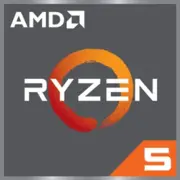Intel Core i5-11600 vs AMD Ryzen 5 5500
CPU Comparison Result
Below are the results of a comparison of Intel Core i5-11600 and AMD Ryzen 5 5500 processors based on key performance characteristics, as well as power consumption and much more.
Advantages
- Larger L3 Cache: 16MB (12MB shared vs 16MB)
- Higher Technology: TSMC 7nm FinFET (14 nm vs TSMC 7nm FinFET)
- Newer Launch Date: April 2022 (March 2021 vs April 2022)
Basic
Intel
Label Name
AMD
March 2021
Launch Date
April 2022
Desktop
Platform
Desktop
i5-11600
Model Name
?
The Intel processor number is just one of several factors - along with processor brand, system configurations, and system-level benchmarks - to be considered when choosing the right processor for your computing needs.
-
Rocket Lake
Code Name
Vermeer
CPU Specifications
6
Total Cores
?
Cores is a hardware term that describes the number of independent central processing units in a single computing component (die or chip).
6
12
Total Threads
?
Where applicable, Intel® Hyper-Threading Technology is only available on Performance-cores.
12
6
Performance-cores
-
-
Basic Frequency
3.6GHz
-
Max Turbo Frequency
?
Max Turbo Frequency is the maximum single-core frequency at which the processor is capable of operating using Intel® Turbo Boost Technology and, if present, Intel® Turbo Boost Max Technology 3.0 and Intel® Thermal Velocity Boost. Frequency is typically measured in gigahertz (GHz), or billion cycles per second.
Up to 4.2GHz
2.8 GHz
Performance-core Base Frequency
-
4.8 GHz
Performance-core Max Turbo Frequency
?
Maximum P-core turbo frequency derived from Intel® Turbo Boost Technology.
-
64K per core
L1 Cache
384KB
512K per core
L2 Cache
3MB
12MB shared
L3 Cache
16MB
LGA-1200
CPU Socket
?
The socket is the component that provides the mechanical and electrical connections between the processor and motherboard.
AM4
-
Unlocked for Overclocking
?
AMD`s product warranty does not cover damages caused by overclocking, even when overclocking is enabled via AMD hardware and/or software. GD-26.
Yes
14 nm
Technology
?
Lithography refers to the semiconductor technology used to manufacture an integrated circuit, and is reported in nanometer (nm), indicative of the size of features built on the semiconductor.
TSMC 7nm FinFET
65 W
TDP
65W
100 °C
Max. Operating Temperature
?
Junction Temperature is the maximum temperature allowed at the processor die.
90°C
-
PCI Express Version
?
PCI Express Revision is the supported version of the PCI Express standard. Peripheral Component Interconnect Express (or PCIe) is a high-speed serial computer expansion bus standard for attaching hardware devices to a computer. The different PCI Express versions support different data rates.
PCIe 3.0
Memory Specifications
DDR4-3200
Memory Type
?
Intel® processors come in four different types: Single Channel, Dual Channel, Triple Channel, and Flex Mode. Maximum supported memory speed may be lower when populating multiple DIMMs per channel on products that support multiple memory channels.
DDR4
128GB
Max Memory Size
?
Max memory size refers to the maximum memory capacity supported by the processor.
-
2
Memory Channels
?
The number of memory channels refers to the bandwidth operation for real world application.
2
-
Bus Speed
Up to 3200MT/s
GPU Specifications
True
Integrated Graphics Model
?
An integrated GPU refers to the graphics core that is integrated into the CPU processor. Leveraging the processor's powerful computational capabilities and intelligent power efficiency management, it delivers outstanding graphics performance and a smooth application experience at a lower power consumption.
Discrete Graphics Card Required
Miscellaneous
-
OS Support
Windows 11 - 64-Bit Edition, Windows 10 - 64-Bit Edition, RHEL x86 64-Bit, Ubuntu x86 64-Bit *Operating System (OS) support will vary by manufacturer.
Benchmarks
Geekbench 6 Single Core
Core i5-11600
2137
+15%
Ryzen 5 5500
1858
Geekbench 6 Multi Core
Core i5-11600
7947
+3%
Ryzen 5 5500
7691
Geekbench 5 Single Core
Core i5-11600
1680
+23%
Ryzen 5 5500
1371
Geekbench 5 Multi Core
Core i5-11600
7722
+20%
Ryzen 5 5500
6436
Passmark CPU Single Core
Core i5-11600
3288
+7%
Ryzen 5 5500
3060
Passmark CPU Multi Core
Core i5-11600
18113
Ryzen 5 5500
19456
+7%








